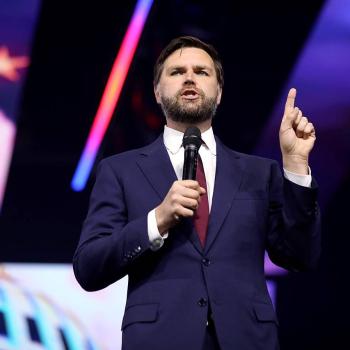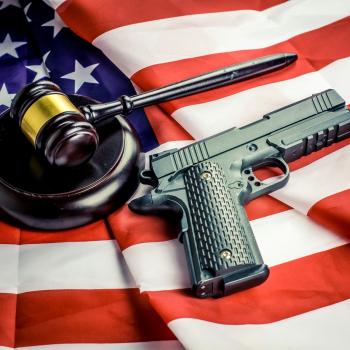With every ritual post-shooting “national discussion,” I grow more weary of saying the same things, and wary of suggesting that anything may be different this time. We seem every time to be stuck in a vicious cycle in which public horrors provoke much noise and little action (legislatively or otherwise), having accepted these periodic and increasingly frequent tragedies as the cost of what we think is freedom. At the same time, it’s becoming increasingly hard to deny that we have a serious problem.
I’m not sure whether or not it’s a hopeful sign to see a tangle of talking points sprouting up beyond the usual heated exchanges; that depends on whether they shed new light on the problem or obscure it further. In hope of the former, there are a few recurring points I’ve seen in recent days that bear sorting out.
I’ll start with the most obvious factor in the gun problem: guns. This is not a new point, but it needs to be said, lest I complexify away the most glaring thing.
Former Vox Nova blogger Mark Gordon put it bluntly:
Every country in the world has people with mental health problems. Every country has teenagers that are angry and alienated. Every country has broken families. Every country has been through the sexual revolution. Every country is wrestling with the widespread loss of religious faith and practice. Control for everything you can think of and we still have an outsized problem with violence. No country experiences mass violence on the scale and at the intensity we do. The only rational explanation is exactly the one we spend so much time trying to avoid for the sake of money or ideology: guns. We have too many f—ing guns in this country and they are too easy to acquire.
The mad rush to blame anything and everything else when people are shot and killed, except for the guns that killed them and the ease with which they were acquired, is itself demonstrative of the (literally) deadly chokehold this powerful idol has on American society.
But why are there so many f—ing guns in this country? And why does even the slightest suggestion that this should be at all tempered or regulated meet with such fierce resistance?
A couple of writers republished by the Ron Paul Institute suggest that behind the military-style public shootings, often carried out with military-grade weapons, is a deeper glorification of militarism: a cult of violence glorifying the military-industrial complex through popular culture, or through the military itself. “You want to stop the gun violence?” writes the Rutherford Institute’s John Whitehead. “Stop the worship of violence that permeates our culture.”
Seeing the prevalence of violence as quasi-religious cult may help to explain, on a systemic level, why it’s so difficult to challenge. And the difficulty may be further compounded by additional considerations, on a personalist level, of the motives and mental states of those who perpetrate mass shootings, especially where there are valid concerns about the way these factors are talked about.
Some have mentioned bullying as a factor, particularly in school shootings. I’ve heard from friends evoking their own memories of being bullied at school, pointing to the need for prevention and intervention. Of course, as the same people are also quick to point out, a violent response is never the answer. And addressing this problem, especially in the wake of a shooting, should not and need not lead into any speculative victim-blaming, because human dignity is never a zero-sum equation. But however it begins, violence is a cycle, and will perpetuate itself if left unchecked.
It is not clear that this had been a direct factor for Nikolas Cruz, who apparently had been disturbed for a long time. Nor is it clear exactly where and how the system failed him and his former classmates. What is clear is that he needed help – and that, while some had tried to do what they could, this tragedy, on several fronts, should have been preventable.
Discussing mental health in relation to gun violence is particularly fraught. It’s been increasingly pointed out that broad associations between these two subjects risk stigmatizing mental illness by falsely equating it with violent behavior. It would indeed be dangerous to draw too close a correlation: the US’ high proportion of guns per capita is not matched by a corresponding proportion of people suffering from mental illness, and the majority of such people are not violent. Addressing mental health as a factor in any meaningful way cannot entail scapegoating the mentally ill for the purpose of deflecting attention from the gun problem. On the contrary, where mental health problems are a factor, this does point to the need for certain restrictions. Without blaming people with mental health conditions on the whole for public violence, there must be some assessment of any direct risk someone may pose to their own safety or that of others – which is why some gun control advocacy groups have called for the use of Extreme Risk Protection Orders, to stop preventable tragedies before they happen. This doesn’t only apply in the case of mental illness, but to serious risks or threats of any kind.
After all, the underlying controversy in the gun control debate, as someone reminded me recently, comes down to risk toleration. Nobody, not even the most strident defenders of liberal gun laws, actually wants mass murders to be committed. The difference between the sides of this debate is not whether to consider mass shootings (or accidental deaths, or suicides, or heightened gang violence, or any number of safety hazards) socially acceptable in themselves, but how much risk of these things we are willing to accept; in other words, where the scales fall in weighing threats to human life against threats to personal autonomy.
When those values are set beside each other, James Strock’s suggestions in a measured opinion piece for the Independent Voter Network sound eminently reasonable: “Given the risks presented by gun violence, it’s reasonable to ask that individuals owning firearms meet an appropriate standard.” And, “when the potential of gun violence exists, the law should tilt toward protection of the innocent.” For Christians in particular, life should always take precedence over autonomy, and nonviolent means of protection over violent ones.
Some suggest that there is broader agreement than may appear on such “low-hanging fruit” as background checks, bans on assault rifles and bump stocks, and raising the minimum age to purchase a firearm. It would be a start. And yet any legislative win over the liberalization of violence, however badly needed, would be only that. A multi-faceted problem requires a multi-pronged approach, as organizations such as Sandy Hook Promise have advocated. This is not to encourage any deflection from the problem, but just the opposite: the first step to solving a problem is to admit we have one, and there is no good reason we cannot or should not address it from all possible angles. It’s not an either/or, or even a both/and, but an all-of-the-above.












